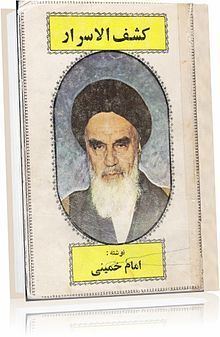Language Arabic | Media type Book | |
 | ||
Works by Ruhollah Khomeini Tahrir al‑Wasilah, The Secret of Prayer, Forty Hadith of Ruhullah, Islamic Government: Governan | ||
Kashf al-Asrar (Arabic: کشف الاسرار Kashf al-Āsrār "Unveiling of Secrets") is a book written in 1943 by Ruhollah Khomeini, the founder of the Islamic Republic of Iran, to respond to the questions and criticisms raised in a 1943 pamphlet titled The Thousand-Year Secrets (Persian: Asrar-i Hazarsala) by Ali Akbar Hakimzadeh, who had abandoned clerical studies at Qom seminary and in the mid-1930s published a modernist journal titled Humayun that advocated reformation in Islam. Kashf al-Asrar is the first book that expresses Khomeini's political views.
Contents
Background
Ruhollah Khomeini wrote Kashf al-Asrar to answer questions about the credibility of Islamic and Shia beliefs that originated in a pamphlet called The Thousand-Year Secrets, which was written by Ali Akbar Hakamizada, who had abandoned clerical studies at Qum seminary. In 1934, Hakamizada began publishing a modernist journal titled Humayun that advocated reformation in Islam and criticized Islamic superstition and traditionalism. In 1943, Hakimzada wrote The Thousand-Year Secrets and invited Shia scholars to explain what he called the sect's superstitious beliefs.
According to Khomeini's son Ahmad, one day when his father was going to Feyziyeh School, he encountered a group of seminary students discussing this pamphlet. Khomeini was worried the views of this pamphlet had infiltrated into the seminaries, and wrote Kashf al-Asrar to answer the pamphlet's questions. Kashf al-Asrar is the first book that expresses Khomeini's political views.
Content
The book defends against Hakamizada's attacks against such Shia practices as the mourning of Muharram, ziyara, the recitation of prayers composed by the Imams, clerical fostering of superstitious beliefs to perpetuate their own power, belief in the intercession of Muhammad and his descendants and the lack of any explicit mention of Imamate in the Quran. Khomeini also attacks Wahhabism and its "idolatrous" devotions, Bahá'í scholar Mírzá Abu'l-Fadl and Shia scholar Shariat Sanglaji.
Kashf al-Asrar consists of six chapters, the ordering of which mirrors the division of content in The Thousand-Year Secrets: "Tawhid", "Imamah", "The Clergy", "Government", "Law", and "Hadith". In the first chapter, "Tawhid", Khomeini answers criticisms of Shia Islam by Bahá'í Faith. The second chapter contains Hadith of Position, Hadith of the two weighty things, and proof of the concept of Imamah by verses of the Quran.
The book's third, fourth, and fifth chapters include a discussion of government in the contemporary age. At the end of The Thousand-Year Secret, Hakamizada asks some challenging questions and invites responses from readers. At the beginning of the third chapter of Kashf al-Asrar, Khomeini responds to five of the nine questions asked in The Thousand-Year Secrets.
Reception
The Thousand-Year Secrets was supported by Ahmad Kasravi and Mohammad Hasan Shariat Sanglaji (d. 1944), the Wahhabi-influenced Shia scholar. Along with the publication of the pamphlet, objections were raised by scholars and seminary students. According to Ayatollah Hossein Badala and Bagheri, some scholars decided to respond to it. One of the responses was written by Mehdi Al-Khalissi; Kashf al-Asrar was another answer to the pamphlet; Ruhollah Khomeini taught philosophy at that time. Qom Seminary selected Kashf al-Asrar as answers to Hakimzada's questions in The Thousand-Year Secrets.
